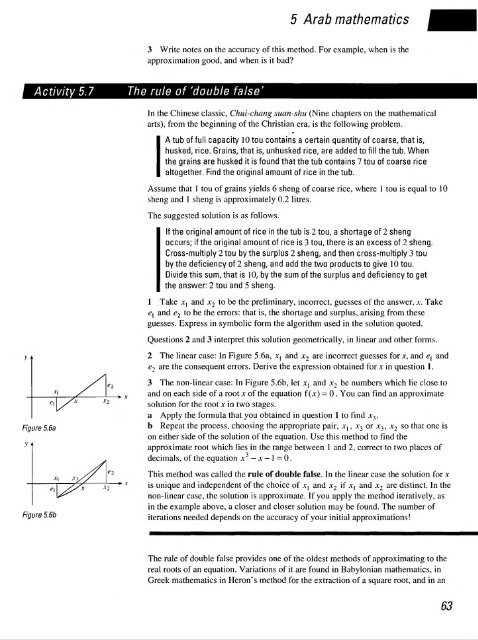history of mathematics - National STEM Centre
history of mathematics - National STEM Centre
history of mathematics - National STEM Centre
Create successful ePaper yourself
Turn your PDF publications into a flip-book with our unique Google optimized e-Paper software.
y i<br />
Activity 5.7<br />
Figure 5.6a<br />
y'<br />
Figure 5.6b<br />
X\ XT.<br />
5 Arab <strong>mathematics</strong><br />
3 Write notes on the accuracy <strong>of</strong> this method. For example, when is the<br />
approximation good, and when is it bad?<br />
The rule <strong>of</strong> 'double false'<br />
In the Chinese classic, Chui-chang suan-shu (Nine chapters on the mathematical<br />
arts), from the beginning <strong>of</strong> the Christian era, is the following problem.<br />
A tub <strong>of</strong> full capacity lOtou contains a certain quantity <strong>of</strong> coarse, that is,<br />
husked, rice. Grains, that is, unhusked rice, are added to fill the tub. When<br />
the grains are husked it is found that the tub contains 7 tou <strong>of</strong> coarse rice<br />
altogether. Find the original amount <strong>of</strong> rice in the tub.<br />
Assume that 1 tou <strong>of</strong> grains yields 6 sheng <strong>of</strong> coarse rice, where 1 tou is equal to 10<br />
sheng and 1 sheng is approximately 0.2 litres.<br />
The suggested solution is as follows.<br />
If the original amount <strong>of</strong> rice in the tub is 2 tou, a shortage <strong>of</strong> 2 sheng<br />
occurs; if the original amount <strong>of</strong> rice is 3 tou, there is an excess <strong>of</strong> 2 sheng.<br />
Cross-multiply 2 tou by the surplus 2 sheng, and then cross-multiply 3 tou<br />
by the deficiency <strong>of</strong> 2 sheng, and add the two products to give 10 tou.<br />
Divide this sum, that is 10, by the sum <strong>of</strong> the surplus and deficiency to get<br />
the answer: 2 tou and 5 sheng.<br />
1 Take x { and x2 to be the preliminary, incorrect, guesses <strong>of</strong> the answer, x. Take<br />
e\ and e2 to be the errors: that is, the shortage and surplus, arising from these<br />
guesses. Express in symbolic form the algorithm used in the solution quoted.<br />
Questions 2 and 3 interpret this solution geometrically, in linear and other forms.<br />
2 The linear case: In Figure 5.6a, x t and x 2 are incorrect guesses for x, and e } and<br />
ei are the consequent errors. Derive the expression obtained for.v in question 1.<br />
3 The non-linear case: In Figure 5.6b, let jc, and x2 be numbers which lie close to<br />
and on each side <strong>of</strong> a root x <strong>of</strong> the equation f (x) = 0. You can find an approximate<br />
solution for the root x in two stages.<br />
a Apply the formula that you obtained in question 1 to find x$.<br />
b Repeat the process, choosing the appropriate pair, x } , x 3 or x3 , x 2 so that one is<br />
on either side <strong>of</strong> the solution <strong>of</strong> the equation. Use this method to find the<br />
approximate root which lies in the range between 1 and 2, correct to two places <strong>of</strong><br />
decimals, <strong>of</strong> the equation x' - x — 1 = 0.<br />
This method was called the rule <strong>of</strong> double false. In the linear case the solution for x<br />
is unique and independent <strong>of</strong> the choice <strong>of</strong> x { and x 2 if jc, and x2 are distinct. In the<br />
non-linear case, the solution is approximate. If you apply the method iteratively, as<br />
in the example above, a closer and closer solution may be found. The number <strong>of</strong><br />
iterations needed depends on the accuracy <strong>of</strong> your initial approximations!<br />
The rule <strong>of</strong> double false provides one <strong>of</strong> the oldest methods <strong>of</strong> approximating to the<br />
real roots <strong>of</strong> an equation. Variations <strong>of</strong> it are found in Babylonian <strong>mathematics</strong>, in<br />
Greek <strong>mathematics</strong> in Heron's method for the extraction <strong>of</strong> a square root, and in an<br />
63
















